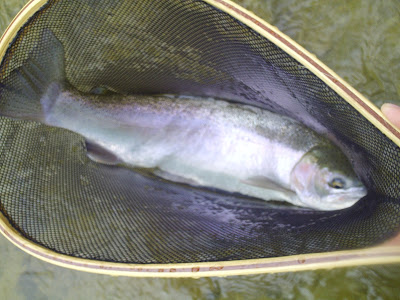I have spent a lot of time playing around with many different materials for attaching stinger hooks to intruder and articulated patterns. Everyone seems to have their own preference and reasons for using different things so I figured I would make a post and share with everyone some of my observations and preferences.
Beading Wire: The first time that I saw wire used for intruders was when a friend of mine tossed me a pattern tied with senyo's intruder wire and shanks. The stiff wire kept the stinger hook straight back from the fly and was still nice and flexible. When I asked how much it was for a package of the wire material I laughed and started looking around for beading wire as a cheaper alternative. I came across a certain brand of wire, Econoflex wire made by the Soft Flex company. It usually runs from $3-5 per spool depending upon the type and has the breaking strength printed right on the package. It comes in wide range of colors, red, black, white, blue, chartreuse etc, as well as different breaking strengths and weaves. The wire is coated in nylon and I have been using the 15lb and 20lb breaking strength wire that is 1X7 strands. I have put these up against a few steelhead without any problems, and more impressively 20-30lb Chinook Salmon. When hooking large salmon I never had a single wire break or fail on me, more often then not it was either the tippet material or the hook itself that would bend out or break.
Pro's:
Cost - At $4-6 per 30+ft roll the price is right and you get lots of use out of a single spool of wire.
Color and Size - The choices in color and size of beading wire is vast which will allow you to find something suitable for what you are tying.
Orientation - Using this wire your hook will stay in line with your fly but still has flex and bend to it when you do hook a fish.
Con's:
Kinks - If you set the hook wrong while tying or fight a few large fish the wire can develop a kink in it.
Availability - The specific brand that I like can be hard to find here in Canada. Lens Mills is the only place that I have seen this specific brand. Aside from that your options are ordering it directly from the Soft Flex company in the U.S, or find alternative wires.
Breaking Strength - Not all wire's list the breaking strength. It would be a smart idea to test the wir
e if the strength is not listed before tying up a dozen flies with it.
Braided Line: I have played with braided line in the 20-60lb range and while many people like and enjoy using it I do not really care for it. I find it is very soft and droopy usually hanging down from the fly as it swings especially with heavier stinger hooks. That being said TONS of people use braided line for attaching hooks and have no problems with hooking up, for me its just a personal preference and prejudice perhaps.
Pro's:
Cost- Relatively cheap, usually $20-30 for a very large spool that will last you a life time.
Availability - Easy to find in any tackle shop or outdoors store.
Con's:
Sag: Hook usually droops below the fly while swinging unless in heavier current.
Crystal Fused Fire Line: This material I would have to say is my favorite and I prefer to use the 30lb test variety. It is a stiffer material that holds the hook straight back behind the fly nicely, but is still soft and flexible. It is white but can be colored with permanent markers (I usually do not bother). I find myself coming back to this material for tying my trailer hooks in time and time again. Once wet it does soak in a bit of water and gets a little softer but not nearly as much as regular braided line. Fire line also makes a few different lines that are very good for trailer hooks, I was given a sample of some 30lb fire line (black coating) by a friend that was a little thinner then the crystal and a tad bit softer, but not as soft as braided line that I did enjoy using as well.
Pro's:
Stiff - The material is stiff enough to hold the hook straight back from the fly while swinging, but is not as stiff as wire.
Durability - The 30lb braid is the lowest I will go when using this material for trailing hooks, and is very durable and does not break down after multiple fish.
Cost -A 300 yard spool of Crystal will cost you roughly $25-30 and last a lifetime unless you are tying commercially.
Con's:
Diameter - The diameter can make things tricky for threading smaller hooks. When using smaller hooks make sure to have a nice clean cut before threading the line through the hook.
Availability- I had to look around pretty hard to find a spool of the 30lb crystal as most places only stocked upto around 14lb. I ended up finding this spool at the Bass Pro Shop in Vaughn, Ontario.
So these are a few of the materials I have played around with extensively and some of the pro's and con's for them. I am curious if you prefer to use something else that I have not listed here? Feel free to comment with your input or tips and tricks. My next blog post will show how I go about attaching a trailer hook to a shank and making it bulletproof in the process.
Tight Lines!
















